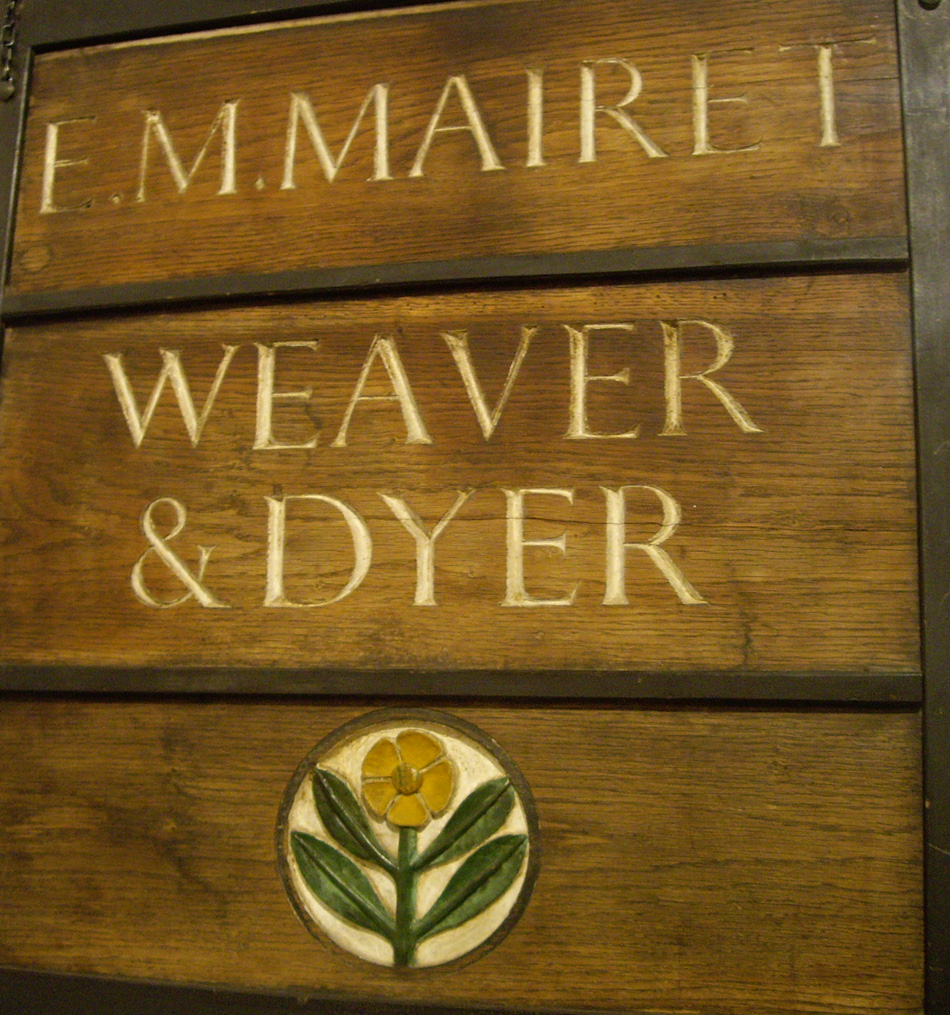From your wonderful comments on the Wovember petition it is obvious that incorrect and confusing descriptions of textiles are abundant. But how has the confusion surrounding the word “WOOL” arisen? Throughout the month we will explore that question in different ways.
This evening we shall hear from Ethel Mairet’s wonderful book published in 1939 and entitled Hand-Weaving To-day, Traditions and changes. Mairet (1872 – 1952) was a teacher, dyer, and weaver and this lovely wooden sign is from the natural dye studio which she ran in Ditchling, Sussex, during the 1920s and 30s.
This is what Ethel Mairet wrote about Synthetic Yarns in 1939;
There are various types of synthetic fibres, differing in their composition and properties. Their general basis is cellulose, derived mostly from cotton, wood, and a few other materials. Rayon, the English name for these fibres, is capable of infinite variety, and is certain of a great future in spite of the many mistakes which have been made in its manufacture. The chief error was the close copying of natural fibres – and the names ‘artifical silk’, ‘artifical wool’, etc., which suggested to the mind materials of very secondary quality. Instead of creating a quality of its own, a new fabric entirely unknown and unforeseen – a new art of the textile world – so far, all it has done is to copy silk, to copy tweeds, velvets and other materials. The new industry has gone the safe way…
Cellophone as used by great textile artists such as Otti Berger, or Rodier, or some of the Finnish weavers, become textiles of rare beauty, holding their place with the greatest textiles of the world. Such artists as these start new ideas for the textile fabrics of the future, eventually to influence the trade because they understand the special qualities inherent in synthetic materials – qualities not found in any of the natural raw materials, and of great creative importance…
What use can the hand-weaver make of rayon or staple fibre? What qualities has it for the textiles of the new architecture and life of the future? What place has cellophane – and the new yarns already invented and those that are still being invented – in the expression of civilisation that is starting? These are the questions for all textile artists to consider. Not by overthrowing all traditional materials and techniques, or by imitating the old textures and yarns, but by the creation, through them, of a new expression in textile.
Given our focus during Wovember on differentiating WOOL from other fibres and textiles, it seems interesting that in Mairet’s time the inventors of new textiles were trying to make them sound like WOOL, such as in the example of ‘artificial wool’ which Mairet cites. Surely these historic developments contributed to today’s situation, where the word WOOL is sometimes used descriptively in situations where no actual WOOL is concerned? Additionally, surely another negative consequence of ‘artificial wool’ is that – in trying to copy WOOL or silk – the inherent creative potentials of synthetic materials may not perhaps have been fully explored.
If polyester is busy trying to be WOOL, then it will always fail at it, in the same way that WOOL would be a terrible substitute for polyester!
The terms of the debate today are slightly different than in Mairet’s time; polyester was patented in 1941 and many subsequent textiles derived from the petrochemical industry raise questions of sustainability and environmental impact not mentioned in Mairet’s discussion of Synthetic Yarns.
However, Mairet’s point about needing to distinguish clearly between different textiles and their unique qualities is still relevant, and the more that we make such distinctions, the more likely it is that we shall have clearer product descriptions on garments in the future.
